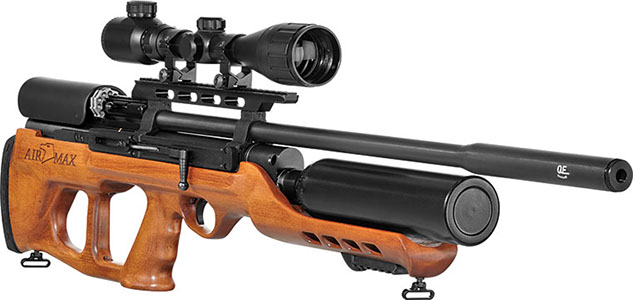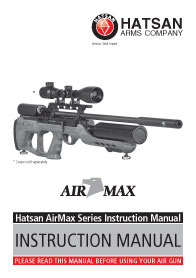AIRMAX

QuietEnergy Barrel Technology
QuietEnergy Sound moderator in muzzle break for reduced down-range noise

- Genuine bullpup design, 10- shot, manual loading, side lever action, pre-charged pneumatic (PCP) air rifle.
- Available in .177 (4.5mm), .22 (5.5mm) and .25 (6.35mm) caliber.
- 200 bar fill pressure 400cc air tube bottle + 90cc air tube.
- QuietEnergy fully shrouded barrel and Integrated Sound Moderator – Approximately 50% Quieter.
- Precision rifled and choked barrel for accuracy.
- Ambidextrous bullpup wooden stock. Picatinny rail beneath the forearm.
- “EasyAdjust” Elevation Comb - Stock equipped with integrated elevation adjustment button.
- Ventilated rubber butt pad.
- Detachable 10-shot rotary magazine in .177 (4.5mm) and .22 (5.5mm) calibers and 9-shot rotary magazine in 25 (6.35mm) caliber.
- Includes 2 magazine.
- Built-in pressure gauge to monitor the pressure.
- Includes quick-fill nozzle supplied in the box.
- Picatinny rail for both 11mm and 22mm scope mounts.
- Overall blued finish, black anodized receiver.
- Manual & Automatic Safety.
- “Anti-double pellet feed” mechanism preventing more than one pellet loading into barrel.
- Patented anti-knock system to prevent gas wastage when rifle is knocked or bounced.
- Quattro Trigger: 2-stage full adjustable match trigger for trigger travel and trigger load.
- Metal trigger.
- Fitted sling swivels.
Technical Specs
* Velocity results may vary as much as 20% due to pellet weight, pellet shape, temperature, elevation, as well as other factors.
* The energy restriction of a particular country can be achieved by the reduction in the muzzle velocity. The above maximum velocity figures are obtained when there is no energy restriction on the air rifle and when measured at optimum pressure value in the air tube. As a nature of PCP air rifles the velocity starts low at maximum pressure level in the air tube, then starts to increase and gets to the maximum at optimum pressure value in the air tube; and then it starts to decrease again as the pressure in the air cylinder gets too low.
Features




